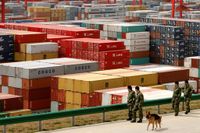In a significant shift in energy policy, Manitoba is set to redirect a portion of its hydroelectric power exports from the United States to local projects. This decision comes as the province prepares to allow two cross-border electricity agreements to expire, according to a report by CBC, citing Manitoba Premier Wab Kinew. The move is part of Manitoba's broader strategy to "bring energy back home" and invest more in Canadian projects amid ongoing trade tensions with the U.S.
Premier Kinew stated that a 500-megawatt export contract will end by the end of this month, and the province has decided to utilize this energy to bolster its own economy. One of the expiring agreements involves a power company based in Minnesota. Kinew mentioned that he has discussed this decision with Minnesota Governor Tim Walz, who understands the rationale behind it. Nevertheless, Manitoba will continue to sell electricity to the United States, Kinew confirmed.
This policy adjustment comes at a time when the Canadian province seeks to enhance its energy independence and economic resilience. The decision to focus on local energy needs reflects a growing trend among regions to prioritize domestic resources over reliance on foreign markets.
Meanwhile, China has reported a remarkable 12.4% increase in exports for March 2025, as businesses rushed to ship products before new tariffs imposed by the Trump administration took effect. The surge in exports highlights the resilience of China's manufacturing sector, which continues to thrive despite ongoing trade tensions between the two economic giants.
According to data from Wind, China's total exports reached $313.9 billion in March, marking a 12.4% rise compared to the same month last year and surpassing both January and February’s growth rates of 2.3%. This increase came even as two previous rounds of U.S. tariffs were already in effect. The statistics suggest that Chinese exporters are adapting quickly to shifting market conditions.
In contrast, imports into China fell by 4.3% year-on-year in March, following an 8.4% decline in the first two months of 2025. This drop in imports contributed to a trade surplus of $102.6 billion for the month. The decline in imports indicates that domestic demand may be weakening, a concern for Chinese policymakers.
The trade relationship between the U.S. and China remains precarious, with President Trump threatening to increase tariffs on Chinese goods up to 145%. Current tariffs on Chinese products have reached as high as 156%, raising the stakes in this ongoing trade war. Despite this, Trump recently announced a temporary suspension of additional tariffs on certain electronic goods from China, adding another layer of complexity to the situation.
For March, exports of Chinese goods to the U.S. rose by 9.08% year-on-year, reflecting a robust demand for Chinese products despite the looming threat of increased tariffs. In the broader Asian market, exports to ASEAN countries grew by 11.55%, with notable increases of 27.78% to Thailand and 18.91% to Vietnam during the same period.
In response to U.S. tariffs, China has implemented its own set of countermeasures, imposing tariffs of 125% on U.S. agricultural products and restricting imports from 28 U.S. companies. Furthermore, 17 U.S. businesses have been added to a list of "unreliable entities," reflecting China's increasingly assertive stance in trade negotiations.
Notably, China's agricultural imports from the U.S. decreased by 18% year-on-year in March, totaling $13.75 billion. This decline is part of a broader strategy to reduce reliance on American agricultural products, as China seeks to bolster its domestic food security.
In the maritime sector, China exported 680 ships in March, representing a remarkable 70.43% increase from the previous year. The total value of ship exports grew by 1.93% to $3.18 billion, showcasing the strength of China's shipbuilding industry.
As China continues to navigate the complexities of international trade, it is also ramping up imports of semiconductors to support its burgeoning technology sector. This strategic move aims to ensure that China remains competitive in the global tech landscape, particularly in light of increasing trade barriers.
Chinese automotive exports also saw significant growth, increasing by 15.91% year-on-year to 568,000 units, with total sales reaching $9.59 billion, a 1.65% increase from last year. Despite previous challenges posed by EU tariffs on electric vehicles, China has managed to expand its exports of hybrid plug-in electric vehicles (PHEVs) to 27 countries.
As the situation evolves, both Manitoba and China are making strategic decisions that reflect their respective priorities in energy and trade. Manitoba's focus on local energy projects illustrates a growing trend towards self-sufficiency, while China's robust export growth highlights its resilience in the face of external pressures. These developments are likely to shape the economic landscapes of both regions in the coming months.





